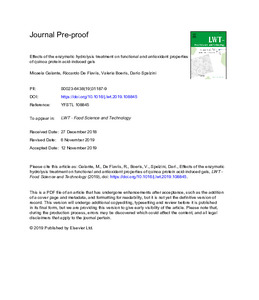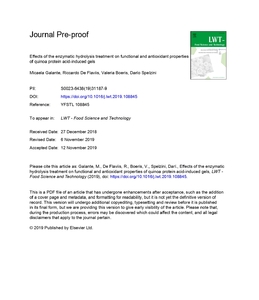Por favor, use este identificador para citar o enlazar este ítem:
https://repositorio.uca.edu.ar/handle/123456789/9925| Título: | Effects of the enzymatic hydrolysis treatment on functional and antioxidant properties of quinoa protein acid-induced gels | Autor: | Galante, Micaela De Flaviis, Riccardo Boeris, Valeria Spelzini, Darío |
Palabras clave: | QUINOA; PROTEINAS; HIDROLISIS; GELES ALIMENTICIOS; INGENIERIA EN ALIMENTOS | Fecha de publicación: | 2020 | Editorial: | Elsevier | Cita: | Galante, M., et al. Effects of the enzymatic hydrolysis treatment on functional and antioxidant properties of quinoa protein acid-induced gels [en línea]. Postprint del artículo publicado en LWT - Food Science and Technology. 2020, 118. doi:10.1016/j.lwt.2019.108845 Disponible en: https://repositorio.uca.edu.ar/handle/123456789/9925 | Resumen: | Abstract: Partial enzymatic hydrolysis is frequently used as strategy to improve the functional and nutritional properties of vegetable proteins. The aim of this work was to evaluate the hydrolysis of quinoa proteins, as well as the functional and antioxidant properties of their acid-induced gels. In order to fulfil this purpose, quinoa protein hydrolysates were obtained using a fungal serin protease. The hydrolysis degree, surface hydrophobicity, sulphydryl group content and the electrophoretic profile of hydrolysates were assayed. Hydrolyzed quinoa protein acid-induced gels were carried out and gels obtained were tested for their textural characteristics, water holding capacity, appearance (color and microstructural properties) as well as for their in vitro antioxidant activity. The changes occurring during the enzymatic hydrolysis affected the gel-forming ability of quinoa proteins and therefore the characteristics of gels. After 3 h of proteolysis, protein hydrolysates with 17 ± 2% hydrolysis degree and low surface hydrophobicity were obtained. Gels obtained of these hydrolysates presented less interconnected protein network and thus, lower textural parameters and lower water holding capacity than control gels. In conclusion, even though the hydrolysis treatment negatively affects the gelling properties of the quinoa proteins, limited hydrolysis enables us to obtain gels with antioxidant capacities which present differential characteristics. | URI: | https://repositorio.uca.edu.ar/handle/123456789/9925 | ISSN: | 0023-6438 | Disciplina: | INGENIERIA EN ALIMENTOS | DOI: | 10.1016/j.lwt.2019.108845 | Derechos: | Acceso abierto. 12 meses de embargo | Fuente: | Postprint del artículo publicado en LWT - Food Science and Technology. 2020, 118 |
| Appears in Collections: | Artículos |
Files in This Item:
| File | Description | Size | Format | |
|---|---|---|---|---|
| effects-enzymatic-hydrolysis-treatment.pdf | 1,69 MB | Adobe PDF |  View/Open | |
| effects-enzymatic-hydrolysis-treatment.jpg | 396,54 kB | JPEG |  View/Open |
Visualizaciones de página(s)
166
comprobado en 30-abr-2024
Descarga(s)
303
comprobado en 30-abr-2024
Google ScholarTM
Ver en Google Scholar
Altmetric
Altmetric
Este ítem está sujeto a una Licencia Creative Commons

